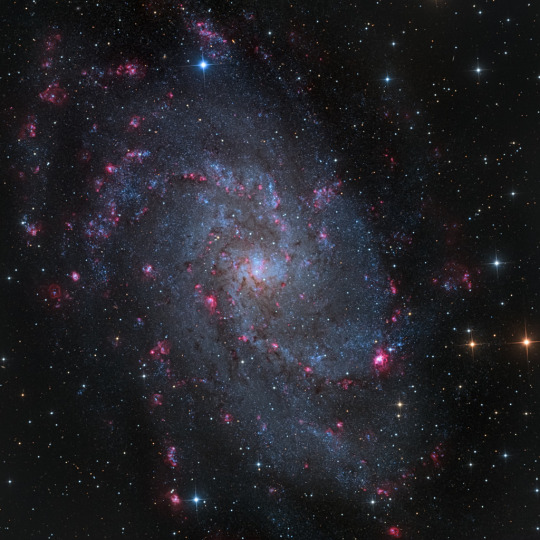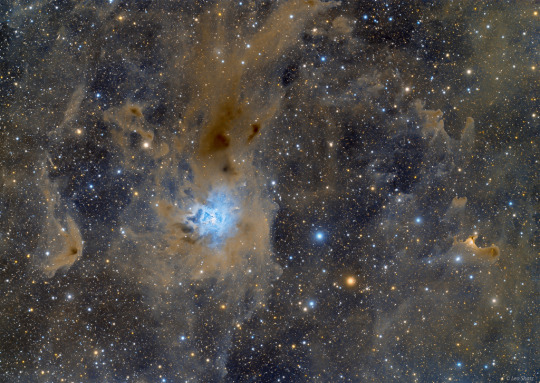Text
instagram (art) / instagram (main)
twitter - endof1nfinity
my art tumblr @endof1nfinity
my art journal tumblr @iloveyouok
Nintendo Friend Code: SW-5262-6365-1331
Xbox gamer tag: lucy3flower
Cashapp: $lucifresh
196 notes
·
View notes
Text

NGC 7023: The Iris Nebula
Image Credit & Copyright: Satwant Kumar
Explanation: These cosmic clouds have blossomed 1,300 light-years away, in the fertile starfields of the constellation Cepheus. Called the Iris Nebula, NGC 7023 is not the only nebula to evoke the imagery of flowers. Still, this deep telescopic image shows off the Iris Nebula's range of colors and symmetries, embedded in surrounding fields of interstellar dust. Within the Iris itself, dusty nebular material surrounds a hot, young star. The dominant color of the brighter reflection nebula is blue, characteristic of dust grains reflecting starlight. Central filaments of the reflection nebula glow with a faint reddish photoluminesence as some dust grains effectively convert the star's invisible ultraviolet radiation to visible red light. Infrared observations indicate that this nebula contains complex carbon molecules known as PAHs. The dusty blue petals of the Iris Nebula span about six light-years.
#uploads#astronomy#astronomy picture of the day#astronomy photography#astrophotography#astro community#astro notes#astro boy#astronaut#astroblr#Astro world#astronomy lover#awesome#trippy#cool#interesting#fav#favorite#outer space#jpg#jpeg#picture#photo#photos#pictures#pic#pics#rad#radical
41 notes
·
View notes
Text
some links > twitter / instagram (art) / instagram (main) / pinterest
my art tumblr @endof1nfinity
my art journal tumblr @iloveyouok
Nintendo Friend Code: SW-5262-6365-1331
Cashapp: $lucifresh
196 notes
·
View notes
Text

A Perseid Below
NASA pic of the day for 08/08/2021
Image Credit: NASA ISS Expedition 28 Crew, Ron Garan
Explanation: Earthlings typically watch meteor showers by looking up. But this remarkable view, captured on August 13, 2011 by astronaut Ron Garan, caught a Perseid meteor by looking down. From Garan's perspective onboard the International Space Station orbiting at an altitude of about 380 kilometers, the Perseid meteors streak below, swept up dust left from comet Swift-Tuttle heated to incandescence. The glowing comet dust grains are traveling at about 60 kilometers per second through the denser atmosphere around 100 kilometers above Earth's surface. In this case, the foreshortened meteor flash is right of frame center, below the curving limb of the Earth and a layer of greenish airglow, just below bright star Arcturus. Want to look up at a meteor shower? You're in luck, as the 2021 Perseids meteor shower peaks this week. This year, even relatively faint meteors should be visible through clear skies from a dark location as the bright Moon will mostly absent.
#astronomy#awesome#nasa#outer space#astrophotography#beautiful#jpg#jpgs#photo#photo of the day#photo of the year#photo of the week#photo of the night#photo of the month#outer space pics#pic of the month#pic of the night#pic of the week#pic of the day#astronomy lover#astronaut#astronout#astro notes#earth#planet earth#planet#sky
10 notes
·
View notes
Text

M33: The Triangulum Galaxy
Image Credit & Copyright: Bernard Miller
Explanation: The small, northern constellation Triangulum harbors this magnificent face-on spiral galaxy, M33. Its popular names include the Pinwheel Galaxy or just the Triangulum Galaxy. M33 is over 50,000 light-years in diameter, third largest in the Local Group of galaxies after the Andromeda Galaxy (M31), and our own Milky Way. About 3 million light-years from the Milky Way, M33 is itself thought to be a satellite of the Andromeda Galaxy and astronomers in these two galaxies would likely have spectacular views of each other's grand spiral star systems. As for the view from planet Earth, this sharp image shows off M33's blue star clusters and pinkish star forming regions along the galaxy's loosely wound spiral arms. In fact, the cavernous NGC 604 is the brightest star forming region, seen here at about the 4 o'clock position from the galaxy center. Like M31, M33's population of well-measured variable stars have helped make this nearby spiral a cosmic yardstick for establishing the distance scale of the Universe.
#astronomy#pic#pic of the day#pictures#nasa#galaxy#triangulum#Triangulum galaxy#galaxies#astrophotography#stars#outer space#spiral galaxy#spiral#beautiful#trippy#awesome#knowledge#astronomy lover#rad#radical#jpg#jpgs#photo of the month#photo of the week#pics
137 notes
·
View notes
Photo

“Still bright in planet Earth's night skies, good telescopic views of Saturn and its beautiful rings often make it a star at star parties. But this stunning view of Saturn's rings and night side just isn't possible from telescopes closer to the Sun than the outer planet. They can only bring Saturn's day into view. In fact, this image of Saturn's slender sunlit crescent with night's shadow cast across its broad and complex ring system was captured by the Cassini spacecraft. A robot spacecraft from planet Earth, Cassini called Saturn orbit home for 13 years before it was directed to dive into the atmosphere of the gas giant on September 15, 2017. This magnificent mosaic is composed of frames recorded by Cassini's wide-angle camera only two days before its grand final plunge. Saturn's night will not be seen again until another spaceship from Earth calls.”
- NASA’s explanation of the NASA photo of the day.
#nasa#outer space#astronomy#astronomical#photo#photo of the day#photos#jpg#jpeg#jpgs#jpegs#pic#pic of the day#pic of the night#pic of the week#pics#pic of the month#nasas#saturn#astrophotography#planet#planets#love#love astronomy#science#scientific#beautiful#awesome#amazing#pretty
23 notes
·
View notes
Photo

Haunting the Cepheus Flare
Image Credit & Copyright: Leo Shatz
“Spooky shapes seem to haunt this dusty expanse, drifting through the night in the royal constellation Cepheus. Of course, the shapes are cosmic dust clouds visible in dimly reflected starlight. Far from your own neighborhood, they lurk above the plane of the Milky Way at the edge of the Cepheus Flare molecular cloud complex some 1,200 light-years away. Over 2 light-years across and brighter than most of the other ghostly apparitions, vdB 141 or Sh2-136 is also known as the Ghost Nebula, seen at the right of the starry field of view. Inside the nebula are the telltale signs of dense cores collapsing in the early stages of star formation. With the eerie hue of dust reflecting bluish light from hot young stars of NGC 7023, the Iris Nebula stands out against the dark just left of center. In the broad telescopic frame, these fertile interstellar dust fields stretch almost seven full moons across the sky.“
#nasa#photo#astronomy#favorite#fav#trippy#psychedelic#outer space#detailed#awesome#2021#old#of#the#day#photo of the day#science#cepheus#cepheus flare#cosmic#dust#clouds#molecular#cloud#complex
14 notes
·
View notes